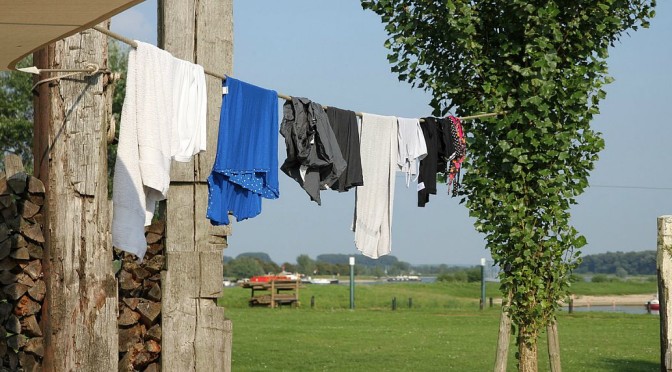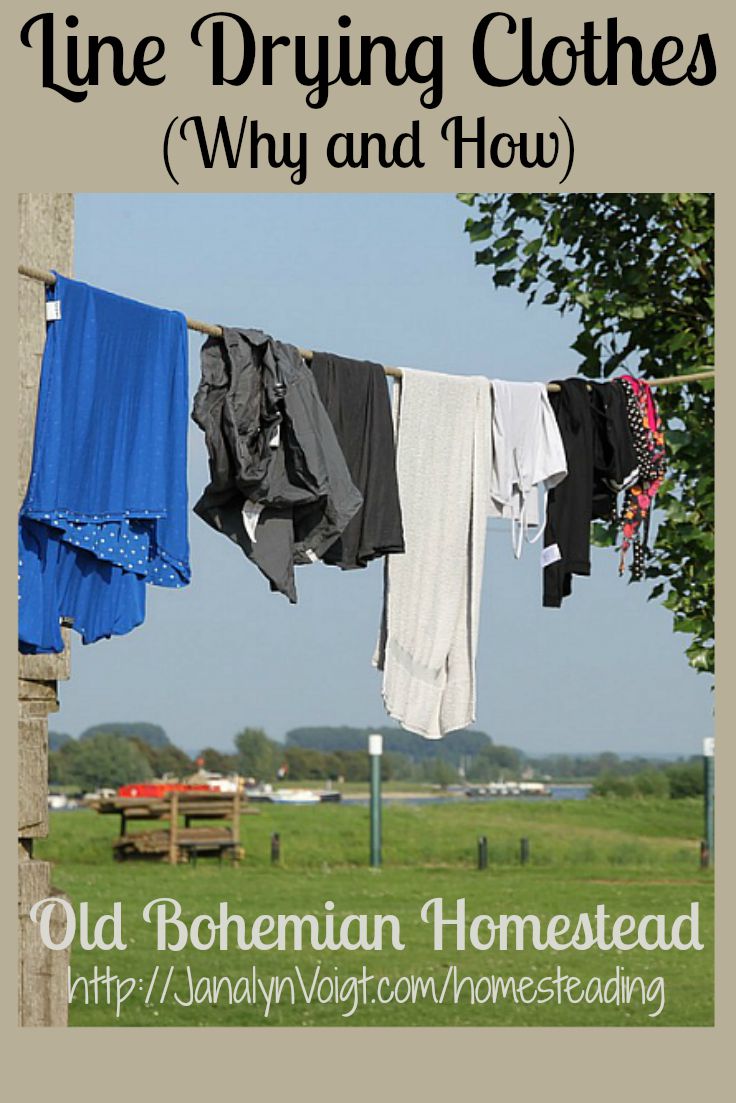Why You Should Line Dry Clothes
Sunshine on your pillow smells much better when acquired by line drying clothes rather than by purchasing laundry detergent chemically altered to replicate this scent. Those products just don’t measure up, and am I the only one who finds this ironic?
If you’ve never dried your wash the time-honored way, you’ll be glad to know that line drying clothes is easier than you may think. Yes, it takes a little more time to hang a wash load rather than tossing it in the dryer, but it’s time well spent because line drying clothes the good, old-fashioned way provides a lot of benefits a dryer can’t give. Like what, exactly? Well…
Line drying clothes:
- Saves you money. With line drying, the load on your electric or gas meter is exactly nothing. Not only that, but you don’t wind up heating your house in the summer, and then having to cool it back down.
- Brightens your whites. Sunlight is a natural bleaching agent that whitens your whites and even removes stains. (Note: if you don’t want bright clothing to bleach out in the sunshine, hang them in the shade or inside out.)
- Disinfects your clothing. Line drying clothes in summer heat removes bacteria.
- Extends the life of your clothing. Dryers create friction that removes fibers from fabric. However, when line drying your clothing, there’s no lint filter to empty.
- Puts a little exercise in your day. Even if your kids are underfoot, you can still get a little exercise in the great outdoors. Carrying a basket o f wet laundry requires you to lift 15 to 18 pounds on average (source), and pinning up your clothes works your arm muscles.
- Reduces wrinkles in clothing. If you snap your clothes before hanging them, you’ll find they have less wrinkles than with clothing dried in the dryer.
- Creates no static cling. It takes electricity to add static to clothing, and since line drying clothes doesn’t call for electricity, it doesn’t cause static cling.
- Relieves stress. The combination of sunshine, mild exercise, and time to think while doing a simple activity all work together to give you an emotional lift that naturally eases stress.
- Humidifies your home in winter. Drying clothes on an indoor drying rack in the winter adds moisture to the air at a time when heaters are drying out the air.
- Adds a heavenly scent to your laundry. If you’ve never rested your head on a line-dried pillow, you are in for a treat. Line-dried laundry smells wonderful. No substitute will do.
Setting Up a Simple Clothesline
(Note: The links, below, are my affiliate links. Using them is a way you can support this site without any additional cost to you.)
To set up a simple clothesline, all you really need to line dry clothes is a rope, something to tie it to, clothespins, and a laundry basket. A line tightener and clothespin holder are nice additions.
The rope you choose should not be stretchy or you’ll constantly be tightening it, which is annoying. My recommendation is to purchase at least 100 feet of cotton clothesline. The plastic-coated variety might repel mildew, but it’s not thick enough to hold the clothespins well.
Something to tie your rope to might be as simple as two trees spaced far enough apart. Or you can tie your rope to eyebolts screwed into upright pillars (mine is under our second-story deck). More involved instructions for clothesline supports can be found online.
Clothespins come in several materials and styles. I suggest using wooden clothespins over plastic ones. One of the joys of drying your clothes on a clothesline is tactile pleasure, in my opinion, plastic or stainless steel just don’t deliver this as well as wood. While I like traditional round-peg clothespinsround-peg clothespins because they come in one piece, and so are less likely to break, I find they pull my clothes and don’t grip as well as spring-loaded wooden clothespins
.
The laundry basket you use will carry a lot of weight over time, so it’s a good idea to purchase one that holds up well and is easy to carry. In my experience, a willow laundry basket with built-in handles works better and lasts longer. I’ve never missed having a liner, and I like that the handles won’t cut into your hands like plastic laundry baskets can.
A clothesline tightener saves you from having to tighten your clothesline by untying and retying it. Purchasing a clothesline tightener doesn’t cost much and is well worth the installation time.
A clothespin holder that attaches to the line and slides along as you work is convenient because it saves you a lot of bending. There are a lot of options available for purchase, but this easy-access clothespin holder slides well and is washable.
Other Clothesline Types
If space is limited, consider using an old-fashioned umbrella clothes rack, a retractable clothesline
, a wall-mount indoor telescoping clothes drying rack
, or a bamboo indoor drying rack
.
How to Line Dry Clothes
- Line drying clothes is really very easy. Just wash your laundry as you normally would, and then carry the wet load in your laundry basket to the clothesline.
- Snap each piece of clothing before hanging it to help prevent wrinkles. Hang your clothing as square as possible and put a clothespin in each corner. If it’s windy, you may want to secure bigger items (like sheets or rugs) with additional clothespins across their length.
- Some people let each clothespin do extra duty by holding the edges of two garments. I don’t like to find wet edges, so I just use a lot of clothespins and clip each item to the line separately.
- I like to hang shirts on plastic clothes hangers (wire hangers might rust), hook the clothes hanger over the line, and clip on a clothespin to hold the hanger in place. This way, when I bring the clothes in from the line, the shirts are already ready to go in the closet.
- I hang sheets on the line with the edges matched evenly and partially fold them on the line.
- Items that are bulky at the top, like jeans, dry best when hung upside down.
- Towels, terry bathrobes, and washcloths get stiff on the clothesline, so I tumble them in the dryer on air fluff for a few minutes after bringing them in from the line. Jeans get stiff, too, but I prefer them to have that texture. If you don’t like it, though, you could do the same with jeans.
- Items with instructions to dry them flat should not be hung on the clothesline.
- Remember to dry clothes you don’t want the sun to bleach in the shade or inside out.
Using a clothesline to dry your clothes is a simple and easy homesteading skill to acquire. Setting up your clothesline and getting in the habit of using it does take a little effort, but the benefits of line drying clothes far outweigh these small costs.



